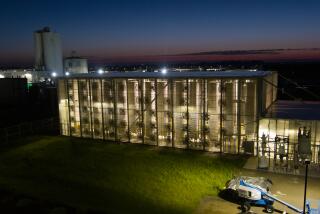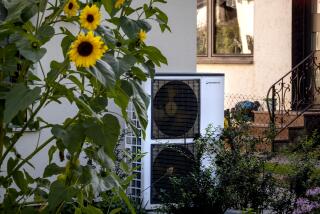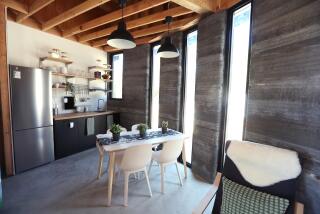Going to Earth for His Heating, Cooling : ‘Inverted-Cave’ Technology Cuts Homeowner’s Electric Bill
- Share via
SHEPHERDSTOWN, W.Va. — Thomas E. Loxley, a former professor at the Virginia Polytechnic Institute, disagrees with conventional thinking in energy-efficient home construction: He refuses to insulate beneath the poured concrete floors that are a feature of all his designs.
A good deal of winter warmth and summer cooling is available in the earth beneath that slab, he contends, so cutting it off with insulation doesn’t make sense. Now, two years of monitoring the test house he built here confirm his beliefs.
Heating and cooling the well-insulated (R-16 around the foundation, R-22 walls, and R-38 ceiling), two-story 2,400-square-foot house, some 50 miles from Washington, consumes less electricity in a year than most conventional electric hot- water heaters.
Combining this earth-available heat with a moderate solar array and a heat pump enabled him to heat and cool the large house for an average $6 a month in electricity costs. According to Potomac Edison records, total heating, cooling, cooking, and hot-water costs in this all-electric house average $33 a month.
What Loxley refers to as “inverted-cave” technology (because a conventional-looking but well-insulated above-ground house can be made to perform like an underground one) is based on a discovery made in New Zealand some two decades ago.
Surprised by Results
New Zealand scientists, experimenting with low-grade earth temperatures as a source of heat for homes, were surprised by the results from some of the test sites. They were yielding considerably more heat than the prevailing soil temperatures indicated they should.
It was found that soil-moisture content made the difference, and John Elder, a scientist with the New Zealand team, was able to prove that moisture convection within the soil increased the available heat by several orders of magnitude.
Knowing of Elder’s work, Loxley, now a consulting engineer, built a house that tapped these moderating earth temperatures.
“Geothermal power is too often visualized only as hot geysers and erupting volcanoes,” Loxley says, “but geologists also talk of low-grade heat flowing through the earth’s surface at about 20 BTU per square foot per hour.” It is this energy that Loxley’s system taps.
“You appreciate the significance of this low-grade energy,” Loxley says, “when you realize that a typical family often expends much of its yearly heating budget just to raise the temperature inside the house to that of the subsoil underneath. This typically represents 38% of the annual heating bill in Buffalo, N.Y., 50% in Seattle, and 54% in Washington, D.C.” Put another way, about half the heat for the Loxley house is supplied by the energy available in the soil below.
Foundation Skirt
The secret to the success of this system is a four-foot deep, insulated foundation skirt that “creates a captive column of moisture within the soil.” By convection, this column draws on the temperature of the earth 15 feet below. At that depth, soil temperatures remain constant year-round--at about the average above-ground temperature for the year. In his area of West Virginia, that amounts to 55 degrees Fahrenheit. Across much of the nation, these constant earth temperatures range from 45 to 65 degrees F.
In winter, soil moisture at the perimeter of the floor slab cools and falls, causing warmer moisture to rise up under the center of the floor. In this way a convective loop is formed, constantly bringing this earth heat from 15 or more feet down to immediately below the concrete floor.
A serpentine array of tubes immediately beneath the concrete slab carries warmed water from the solar array, which is tapped by the heat pump and brought indoors. Any internal heat that is conducted through the concrete floor to the soil below is picked up by these tubes and returned via the heat pump in a constant recycling process.
In summer, Loxley has found that the convective loop reverses itself, rising slowly around the perimeter of the house and falling at its center. In winter the loop brings warmth to the floor; in summer it absorbs unwanted interior heat and transports it away. Excess summer heat is also lost through the floor by conduction.
Cut Utility Bills
Loxley’s calculations suggest that incorporating inverted-cave technology will add about $2,000 to the cost of a home, while cutting annual heating and cooling bills to under $100 a year.
Is there a drawback to this system? Well, yes. For it to work at its best, the slab floor has to be finished in ceramic tile, slate, or brick. Carpeting is acceptable, although it reduces heat transfer somewhat.
A wood floor over a crawl space is totally unacceptable. Another requirement is that the house have no more than two stories and that it be at least 28 to 30 feet wide. The nearer to square an inverted cave home is, the better it will perform, according to its inventor.
Loxley, whose paper on the subject was selected for presentation at the National Bureau of Standards and the National Conference of States on Building Codes and Standards, has not patented his idea. “It would be virtually impossible to enforce,” he says. Instead he has established education programs for interested architects, builders, and consumers.
According to Loxley, “the system can be independently verified very easily,” and he’s hoping universities overseas will do just that.
For his illustrated research guide on the inverted cave home, send $5 to Thomas E. Loxley, PO Box 299F, Shepherdstown, W. Va. 25443.






